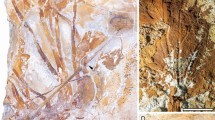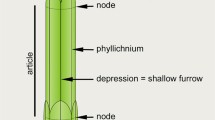Abstract
Due to the immense ecological and economic significance of grasses, their highly characteristic long–short epidermal patterning and associated silica phytoliths represent significant diagnostic markers in studies of ancient climate change and agriculture. We explore the link between epidermal cell patterning and phytolith development and review the evolutionary history of phytoliths in the context of recent well-resolved phylogenetic analyses of grasses and allied Poales, focusing on early-divergent grasses and the subfamilies that constitute the BEP group (the bamboos and their allies). Dimorphic epidermal patterning is a common feature of Poaceae and the related family Joinvilleaceae, where phytoliths are located primarily in the short cells. However, Joinvillea lacks the short-cell pairs that occur in many grasses. The costal rows of phytoliths that characterize some grasses could represent loss of long–short cell patterning over the veins. Unlobed phytoliths probably represent the ancestral condition in grasses, though bilobate phytoliths evolved at an early stage. Either transverse-unlobed or transverse-bilobate phytoliths predominate in the early-divergent lineages, whereas axial-bilobates (or polylobates) primarily characterize the PACMAD clade and the BEP subfamily Pooideae.




Similar content being viewed by others
Literature Cited
Bennett, D. M. 1982. An ultrastructural study on the development of silicified tissues in the leaf tip of barley (Hordeum sativum Jess). Annals of Botany 50: 229–237.
Berlin, A. M., T. B. Ball, R. Thompson, D. Kittleson & S. C. Herbert. 2003. Ptolemaic agriculture, "Syrian wheat," and Triticum aestivum. Journal of Archaeological Science 30: 115–121.
Blackman, E. 1969. Observations on the development of the silica cells of the leaf sheath of wheat (Triticum aestivum). Canadian Journal of Botany 47: 827–838.
——— 1971. Opaline silica bodies in the range grasses of southern Alberta. Canadian Journal of Botany 49: 769–781.
Bremond, L., A. Alexandre, O. Peyroun & J. Guiot. 2008. Definition of grassland biomes from phytoliths in West Africa. Journal of Biogeography 35: 2039–2048.
Christin, P. A., N. Salamin, E. A. Kellogg, A. Vicentini & G. Besnard. 2009. Integrating phylogeny into studies of C4 variation in the grasses. Plant Physiology 149: 82–87.
Currie, H. A. & C. C. Perry. 2007. Silica in plants: biological, biochemical and chemical studies. Annals of Botany 100: 1383–1389.
Cutler, D. F. 1969. Anatomy of the monocotyledons, IV. Juncales. Clarendon, Oxford.
Dorweiler, J. & J. Doebley. 1997. Developmental analysis of Teosinte Glume Architecture 1: a key locus in the evolution of maize (Poaceae). American Journal of Botany 84: 1313–1322.
Duvall, M. R., J. I. Davis, L. G. Clark, J. D. Noll, D. H. Goldman & J. G. Sanchez-Ken. 2007. Phylogeny of the grasses (Poaceae) revisited. Aliso 23: 237–247.
Fry, S. C., B. H. W. Nesselrode, J. G. Miller & B. R. Mewburn. 2008. Mixed-linkage (1→3, 1→4)-β-D-glucan is an major component of Equisetum (horsetail) cell walls. New Phytologist 179: 104–115.
GPWG (Grass Phylogeny Working Group). 2001. Phylogeny and subfamilial classification of the grasses (Poaceae). Annals of the Missouri Botanical Garden 88: 373–457.
GPWG II. 2012. New grass phylogeny resolves deep evolutionary relationships and discovers C4 origins. New Phytologist 193: 304–312.
Ge, S., A. Li, B. R. Lu, S. Z. Zhang & D. Y. Hong. 2002. A phylogeny of the rice tribe Oryzeae (Poaceae) based on matk sequence data. American Journal of Botany 89: 1967–1972.
Givnish, T. J., M. Ames, J. R. McNeal, M. R. McKain, P. R. Steele, C. W. dePamphilis, S. W. Graham, J. C. Pires, D. W. Stevenson, W. B. Zomlefer, B. G. Briggs, M. R. Duvall, M. J. Moore, J. M. Heaney, D. E. Soltis, P. S. Soltis, K. Thiele & J. H. Leebens-Mack. 2010. Assembling the tree of the monocotyledons: plastome sequence phylogeny and evolution of Poales. Annals of the Missouri Botanical Garden 97: 584–616.
Judziewicz, E. J. & T. R. Soderstrom. 1989. Morphological, anatomical and taxonomic studies in Anomochloa and Streptochaeta (Poaceae: Bambusoideae). Smithsonian Contributions to Botany 68: 1–52.
Kauff, F., P. J. Rudall & J. G. Conran. 2000. Systematic root anatomy of Asparagales and other monocotyledons. Plant Systematics and Evolution 223: 139–154.
Kaufman, P. B., L. B. Petering & J. G. Smith. 1970. Ultrastructural development of cork-silica cell pairs in Avena internodal epidermis. Botanical Gazette 131: 173–185.
Kellogg, E. A. 2000. The grasses: a case study in macroevolution. Annual Reviews in Ecology and Systematics 31: 217–238.
——— 2001. Evolutionary history of the grasses. Plant Physiology 125: 1198–1205.
———2009. The evolutionary history of Ehrhartoideae, Oryzeae, and Oryza. Rice 2: 1–14.
Kim, C. M. & L. Dolan. 2011. Root hair development involves asymmetric cell division in Brachypodium distachyon and symmetric division in Oryza sativa. New Phytologist 192: 601–610.
Le Blond, J. S., S. Strekopytov, C. Unsworth & B. J. Williamson. 2011. Testing a new method for quantifying Si in silica-rich biomass using HF in a closed vessel microwave digestion system. Analytical Methods 3: 1752–1758.
Linder, H. P. & P. J. Rudall. 2005. The evolutionary history of Poales. Annual Reviews in Ecology, Evolution and Systematics 36: 107–124.
Lu, H., J. Zhang, N. Wu, K. Liu, D. Xu & Q. Li. 2009. Phytoliths analysis for the discrimination of Foxtail Millet (Setaria italica) and Common Millet (Panicum miliaceum). PLoS One 4: e4448.
Ma, J. F. & N. Yamaji. 2006. Silicon uptake and accumulation in higher plants. Trends in Plant Science 11: 392–397.
Madella, M. A., A. Alexandre & T. Ball. 2005. International code for phytolith nomenclature 1.0. Annals of Botany 96: 253–260.
Mehra, P. N. & O. P. Sharma. 1965. Epidermal silica cells in the Cyperaceae. Botanical Gazette 126: 53–58.
Metcalfe, C. R. 1960. Anatomy of the Monocotyledons. I. Gramineae. Clarendon, Oxford.
Nakamura, M., C. S. Kiefer & M. Grebe. 2012. Planar polarity, tissue polarity and planar morphogenesis in plants. Current Opinion in Plant Biology 15: 593–600.
Prasad, V., C. A. E. Strömberg, H. Alimohammadian & A. Sahni. 2005. Dinosaur coprolites and the early evolution of grasses and grazers. Science 310: 1177–1180.
———, ———, A. D. Leaché, R. Patnaik, L. Tang, D. M. Mohabey, S. Ge & A. Sahni. 2011. Late Cretaceous origin of the rice tribe provides evidence for early diversification in Poaceae. Nature Communications 2: 480. doi:10.1038/ncomms1482.
Prychid, C. J., P. J. Rudall & M. Gregory. 2003. Systematics and biology of phytoliths in monocotyledons. Botanical Review 69: 377–440.
Renvoize, S. 1982. A survey of leaf-blade anatomy in grasses. I. Andropogoneae. II. Arundinelleae. Kew Bulletin 37(315–321): 489–495.
——— 1983. A survey of leaf-blade anatomy in grasses. IV. Eragrostideae. Kew Bulletin 38: 469–478.
——— 1985. A survey of leaf-blade anatomy in grasses. V. The Bamboo allies. VI Stipeae. VII Pommereulleae, Orcuttieae and Pappophoreae. Kew Bulletin 40: 509–535, 731–736, 737–744.
——— 1986. A survey of leaf-blade anatomy in grasses. VIII. Arundinoideae. IX. Centothecoideae. Kew Bulletin 41: 323–338, 339–342.
——— 1987. A survey of leaf-blade anatomy in grasses. X: Bambuseae. XI: Paniceae. Kew Bulletin 42: 201–207, 739–768.
Sánchez-Ken, J. G., L. G. Clark, E. A. Kellogg & E. E. Kay. 2007. Reinstatement and emendation of subfamily Micrairoideae (Poaceae). Systematic Botany 32: 71–80.
——— & ———. 2010. Phylogeny and a new tribal classification of the Panicoideae s.l. (Poaceae) based on plastid and nuclear sequence data and structural data. American Journal of Botany 97: 1732–1748.
Schoelynck, J., K. Bal, H. Backx, T. Okruszko, P. Meire & E. Struyf. 2010. Silica uptake in aquatic and wetland macrophytes: a strategic choice between silica, lignin and cellulose? New Phytologist 186: 385–391.
Soderstrom, T. R., R. P. Ellis & E. J. Judziewicz. 1987. The Phareae and Streptogyneae (Poaceae) of Sri Lanka: a morphological–anatomical study. Smithsonian Contributions to Botany 65: 1–27.
Sørensen, I., F. A. Pettolino, S. M. Wilson, B. Doblin, A. B. Johansen & W. G. Willats. 2008. Mixed-linkage (1→3), (1→4)-β-D-glucan is not unique to the Poales and is an abundant component of Equisetum arvense cell walls. The Plant Journal 54: 510–521.
Stebbins, G. L. & S.S. Shah. 1960. Developmental studies of cell differentiation in the epidermis of monocotyledons. II. Cytological features of stomatal development in the Gramineae. Developmental Biology 2: 477–500.
Strömberg, C. A. E. 2005. Decoupled taxonomic radiation and ecological expansion of open-habitat grasses in the Cenozoic of North America. Proceedings of the National Academy of Sciences 102: 11980–11984.
Tateoka, T. 1963. Notes on Some Grasses. XIII. Relationship between Oryzeae and Ehrharteae, with special reference to leaf anatomy and histology. Botanical Gazette 124: 264–270.
Terrell, E. E. & W. P. Wergin. 1981. Epidermal features and silica deposition in lemmas and awns of Zizania (Gramineae). American Journal of Botany 68: 697–707.
Tomlinson, P. B. 1969. Anatomy of the Monocotyledons III Commelinales—Zingiberales. Clarendon, Oxford.
Zeiger, E. & G. L. Stebbins. 1972. Developmental genetics in barley: a mutant for stomatal development. American Journal of Botany 59: 143–148.
Zhang, J., H. Lu, N. Wu, X. Yang & X. Diao. 2011. Phytolith analysis for differentiating between Foxtail Millet (Setaria italica) and Green Foxtail (Setaria viridis). PLoS One 6: e19726.
Zhao, Z., D. M. Pearsall, R. A. Benfer & D. R. Piperno. 1998. Distinguishing rice (Oryza sativa Poaceae) from wild Oryza species through phytolith analysis. II: finalized method. Economic Botany 52: 134–145.
Acknowledgments
We thank Richard Bateman and Jerrold Davis for critically reading the manuscript.
Author information
Authors and Affiliations
Corresponding author
Rights and permissions
About this article
Cite this article
Rudall, P.J., Prychid, C.J. & Gregory, T. Epidermal Patterning and Silica Phytoliths in Grasses: An Evolutionary History. Bot. Rev. 80, 59–71 (2014). https://doi.org/10.1007/s12229-014-9133-3
Published:
Issue Date:
DOI: https://doi.org/10.1007/s12229-014-9133-3




